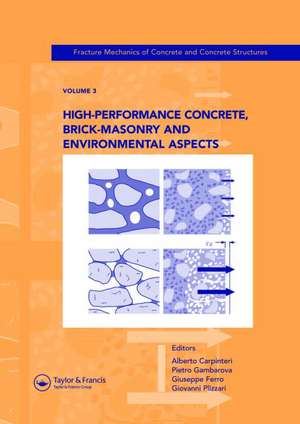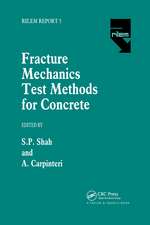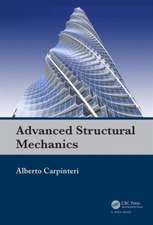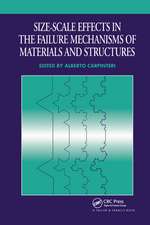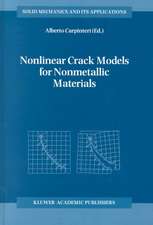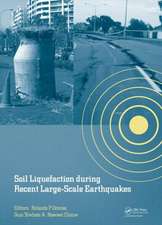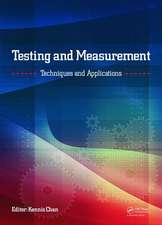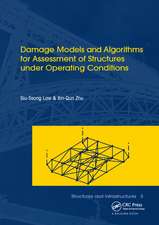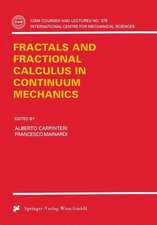High-Performance Concrete, Brick-Masonry and Environmental Aspects: Fracture Mechanics of Concrete and Concrete Structures, Vol. 3 of the Proceedings of the 6th International Conference on Fracture Mechanics of Concrete and Concrete Structures, Catania, Italy, 17-22 June 2007, 3-Volumes
Editat de Alberto Carpinteri, Pietro G. Gambarova, Giuseppe Ferro, Giovanni A. Plizzarien Limba Engleză Hardback – 31 mai 2007
Concrete technology has developed at a fast pace during the last two decades and material performance has been significantly improved. High-performance concrete (HPC) is now a reality. Initially, attention focused on compressive strength and the enhanced concrete was named “high-strength concrete” (HSC). Later, however, other issues arose, such as workability and durability. There was an increasing demand for enhanced rheology (in terms of flowability and cohesion, i.e. no segregation effects) in the fresh state, and compactness in the hardened state. Researchers responded with the development of self-consolidating concrete (SCC). Since higher strength generally implies higher brittleness, fibre-reinforced concrete (FRC) has generated considerable interest for its enhanced toughness under both static and dynamic loading, as well as for its ability to control concrete cracking. Nowadays, there are many types of fibre on the market, with different material and geometric qualities. The remarkable toughness of FRC, due to its fracture energy, combined with advances of nonlinear fracture-mechanics in modelling the structural behaviour, means that the advantages of incorporating fibres can be fully exploited. Furthermore, by adopting optimized mix-designs (in terms of fibre content and type, and of pozzolanic or hydraulically-active adjuncts) the increasingly important requirements of durability can be met, even under the most severe environmental conditions (like chemical aggression, high and low temperatures, and fatigue). Recently, the field of fracture mechanics has extended to other brittle or quasi-brittle materials, such as brick-masonry, glass, polymers and ice, and a more realistic evaluation of the safety level of structures has been obtained.
The other two volumes comprising the Proceedings of the 6th International Conference on Fracture Mechanics of Concrete and Concrete Structures are New Trends in Fracture Mechanics of Concrete; and Design, Assessment and Retrofitting of RC Structures. this set presents a wealth of information, and will be useful to professional civil engineers, postgraduate students and researchers.
Preț: 862.42 lei
Preț vechi: 1149.08 lei
-25% Nou
Puncte Express: 1294
Preț estimativ în valută:
165.02€ • 172.30$ • 136.58£
165.02€ • 172.30$ • 136.58£
Carte tipărită la comandă
Livrare economică 05-19 aprilie
Preluare comenzi: 021 569.72.76
Specificații
ISBN-13: 9780415446174
ISBN-10: 0415446171
Pagini: 648
Dimensiuni: 174 x 246 mm
Greutate: 1.27 kg
Ediția:1
Editura: CRC Press
Colecția CRC Press
ISBN-10: 0415446171
Pagini: 648
Dimensiuni: 174 x 246 mm
Greutate: 1.27 kg
Ediția:1
Editura: CRC Press
Colecția CRC Press
Cuprins
Preface to Volume3
Sponsors
VOLUME 1 – New Trends in Fracture Mechanics of Concrete
Part I Theoretical and numerical Methods in fracture mechanics of concrete
Part II Experimental Methods in Fracture Mechanics of Concrete
Part III Constitutive damage modelling of concrete
Part IV Time effects in the damage and fracture of concrete
VOLUME 2 – Design, Assessment and Retrofitting of RC Structures
Part V Theoretical and Experimental Investigation on the Mechanical Behavior
of RC Structures
Part VI Practical Problems in RC Structural Applications
Part VII Monitoring and assessment of RC structures
Part VIII Maintenance and retrofitting of RC structures
VOLUME 3 – High-Performance Concrete, Brick-Masonry and
Environmental Aspects
Part IX High-Performance Concrete
Part X Fibre reinforced concrete
Part XI Brick-masonry and other Quasi-brittle materials
Part XII Environmental Issues
Sponsors
VOLUME 1 – New Trends in Fracture Mechanics of Concrete
Part I Theoretical and numerical Methods in fracture mechanics of concrete
Part II Experimental Methods in Fracture Mechanics of Concrete
Part III Constitutive damage modelling of concrete
Part IV Time effects in the damage and fracture of concrete
VOLUME 2 – Design, Assessment and Retrofitting of RC Structures
Part V Theoretical and Experimental Investigation on the Mechanical Behavior
of RC Structures
Part VI Practical Problems in RC Structural Applications
Part VII Monitoring and assessment of RC structures
Part VIII Maintenance and retrofitting of RC structures
VOLUME 3 – High-Performance Concrete, Brick-Masonry and
Environmental Aspects
Part IX High-Performance Concrete
Part X Fibre reinforced concrete
Part XI Brick-masonry and other Quasi-brittle materials
Part XII Environmental Issues
Notă biografică
Alberto Carpinteri, Pietro G. Gambarova, Giuseppe Ferro, Giovanni A. Plizzari
Descriere
These proceedings present a wealth of information on Fracture Mechanics of Concrete and Concrete Structures, and will be useful to professional civil engineers, postgraduate students and researchers.
